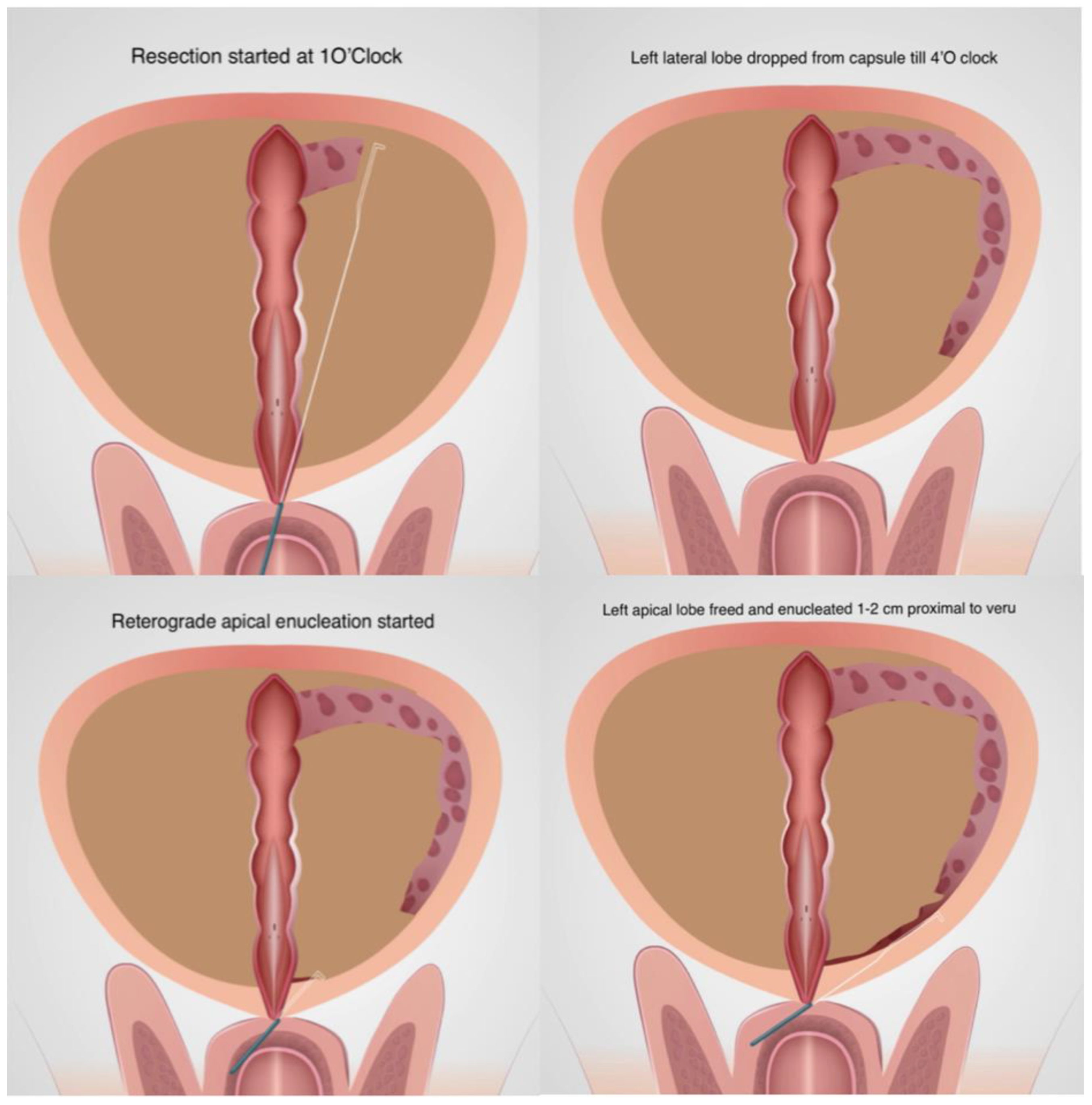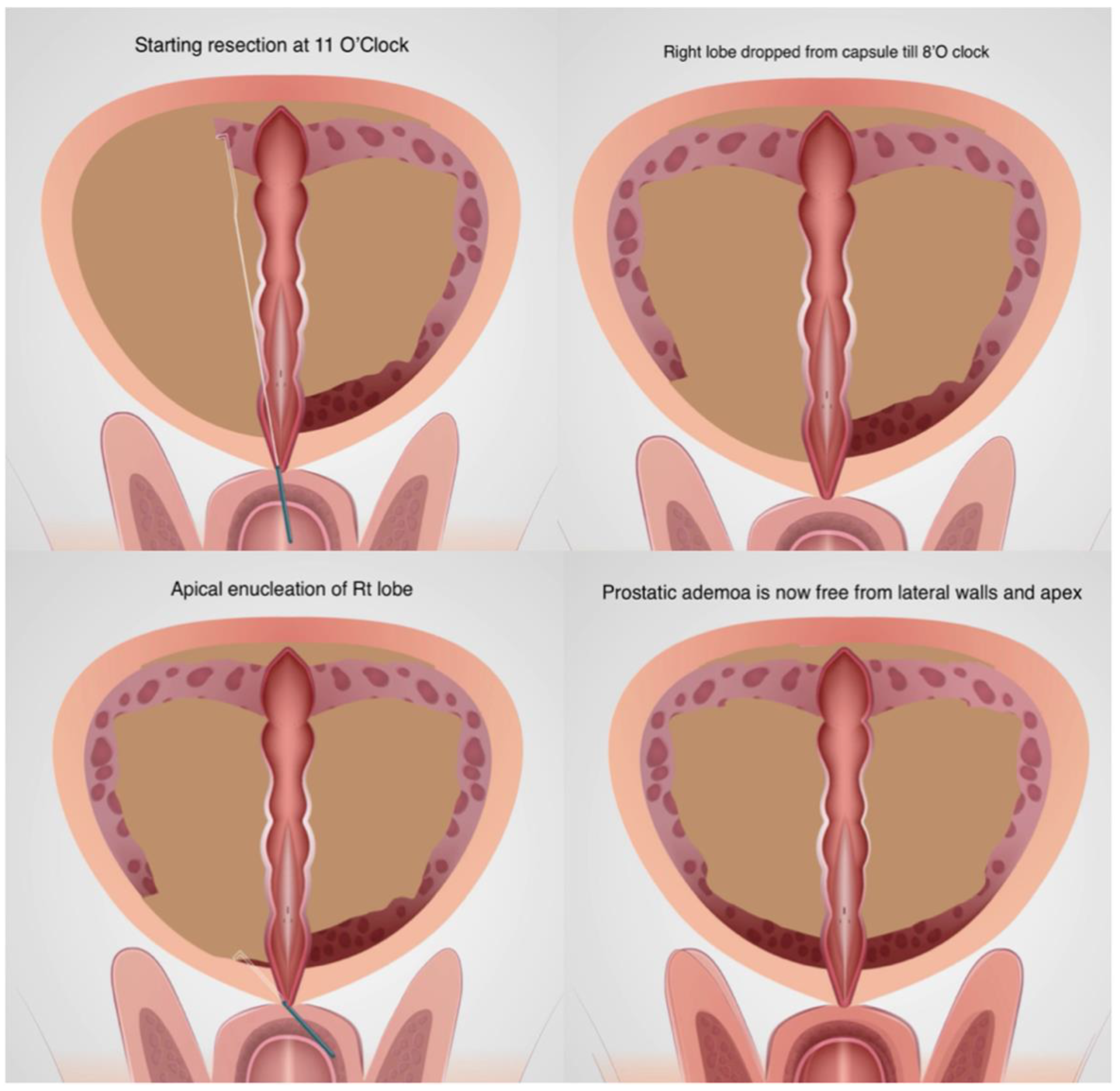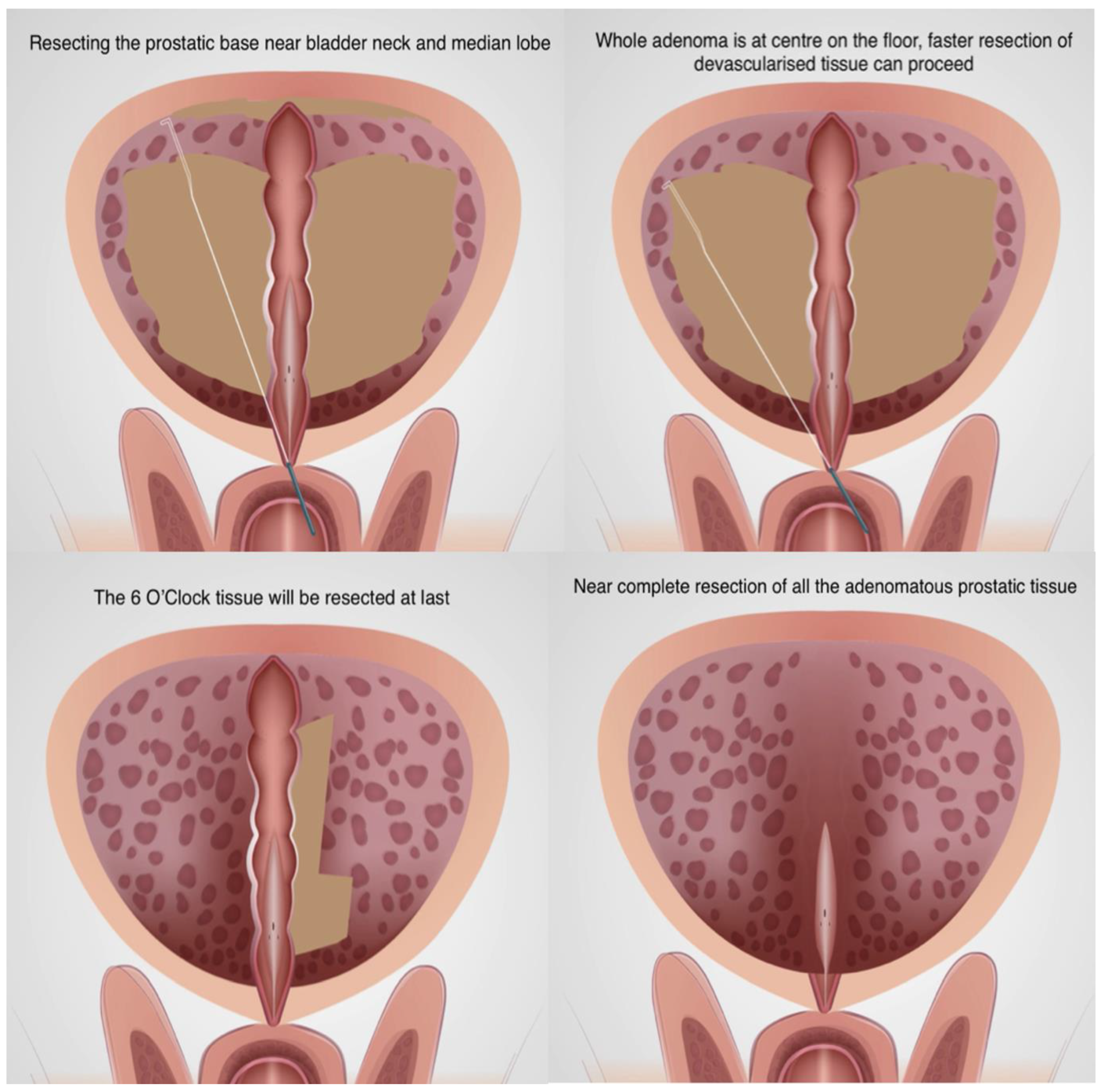Monopolar Transurethral Enucleoresection of Prostate: Feasibility of Modified Nesbit’s Enucleoresection with Apical Release
Abstract
1. Introduction and Objective
2. Methods
3. Results
4. Discussion
5. Conclusions
Author Contributions
Funding
Institutional Review Board Statement
Informed Consent Statement
Data Availability Statement
Conflicts of Interest
References
- Lokeshwar, S.D.; Harper, B.T.; Webb, E.; Jordan, A.; Dykes, T.A.; Neal, D.E., Jr.; Terris, M.K.; Klaassen, Z. Epidemiology and treatment modalities for the management of benign prostatic hyperplasia. Transl. Androl. Urol. 2019, 8, 529. [Google Scholar] [CrossRef]
- Gravas, S.; Gacci, M.; Gratzke, C.; Herrmann, T.R.; Karavitakis, M.; Kyriazis, I.; Malde, S.; Mamoulakis, C.; Rieken, M.; Sakalis, V.I.; et al. Summary Paper on the 2023 European Association of Urology Guidelines on the Management of Non-neurogenic Male Lower Urinary Tract Symptoms. Eur. Urol. 2023, 84, 207–222. [Google Scholar] [CrossRef]
- Omar, M.I.; Lam, T.B.; Alexander, C.E.; Graham, J.; Mamoulakis, C.; Imamura, M.; Maclennan, S.; Stewart, F.; N’dow, J. Systematic review and meta-analysis of the clinical effectiveness of bipolar compared with monopolar transurethral resection of the prostate (TURP). BJU Int. 2014, 113, 24–35. [Google Scholar] [CrossRef] [PubMed]
- Zhang, Y.; Yuan, P.; Ma, D.; Gao, X.; Wei, C.; Liu, Z.; Li, R.; Wang, S.; Liu, J.; Liu, X. Efficacy and safety of enucleation vs. resection of prostate for treatment of benign prostatic hyperplasia: A meta-analysis of randomized controlled trials. Prostate Cancer Prostatic Dis. 2019, 22, 493–508. [Google Scholar] [CrossRef]
- Gilling, P.J.; Wilson, L.C.; King, C.J.; Westenberg, A.M.; Frampton, C.M.; Fraundorfer, M.R. Long-term results of a randomized trial comparing holmium laser enucleation of the prostate and transurethral resection of the prostate: Results at 7 years. BJU Int. 2012, 109, 408–411. [Google Scholar] [CrossRef]
- Enikeev, D.; Rapoport, L.; Gazimiev, M.; Allenov, S.; Inoyatov, J.; Taratkin, M.; Laukhtina, E.; Sung, J.M.; Okhunov, Z.; Glybochko, P. Monopolar enucleation versus transurethral resection of the prostate for small-and medium-sized (<80 cc) benign prostate hyperplasia: A prospective analysis. World J. Urol. 2020, 38, 167–173. [Google Scholar] [PubMed]
- Hartung, F.O.; Kowalewski, K.F.; von Hardenberg, J.; Worst, T.S.; Kriegmair, M.C.; Nuhn, P.; Herrmann, T.R.; Michel, M.S.; Herrmann, J. Holmium versus thulium laser enucleation of the prostate: A systematic review and meta-analysis of randomized controlled trials. Eur. Urol. Focus 2022, 8, 545–554. [Google Scholar] [CrossRef]
- Hiraoka, Y.; Lin, T.; Tsuboi, N.; Nakagami, Y. Transurethral enucleation of benign prostatic hyperplasia. J. Nippon. Med. Sch. 1986, 53, 212–215. [Google Scholar] [CrossRef] [PubMed]
- Herrmann, T.R. Enucleation is enucleation is enucleation is enucleation. World J. Urol. 2016, 34, 1353–1355. [Google Scholar] [CrossRef]
- Saitta, G.; Becerra, J.E.; Del Álamo, J.F.; González, L.L.; Elbers, J.R.; Suardi, N.; Gómez-Sancha, F. ‘En Blo’HoLEP with early apical release in men with benign prostatic hyperplasia. World J. Urol. 2019, 37, 2451–2458. [Google Scholar] [CrossRef]
- Patel, R.M.; Bariol, S. National trends in surgical therapy for benign prostatic hyperplasia in Australia. ANZ J. Surg. 2019, 89, 345–349. [Google Scholar] [CrossRef]
- Zhang, T.R.; Thorogood, S.L.; Sze, C.; Fisch, R.; Chughtai, B.; Te, A.; Lee, R.K.; Hu, J.C. Current Practice Patterns in the Surgical Management of Benign Prostatic Hyperplasia. Urology 2023, 175, 157–162. [Google Scholar] [CrossRef] [PubMed]
- Checcucci, E.; Veccia, A.; De Cillis, S.; Piramide, F.; Volpi, G.; Amparore, D.; Pecoraro, A.; Piana, A.; Granato, S.; Verri, P.; et al. New ultra-minimally invasive surgical treatment for benign prostatic hyperplasia: A systematic review and analysis of comparative outcomes. Eur. Urol. Open Sci. 2021, 33, 28–41. [Google Scholar] [CrossRef] [PubMed]
- Franz, J.; Suarez-Ibarrola, R.; Pütz, P.; Sigle, A.; Lusuardi, L.; Netsch, C.; Lehrich, K.; Herrmann, T.R.; Gratzke, C.; Miernik, A. Morcellation after endoscopic enucleation of the prostate: Efficiency and safety of currently available devices. Eur. Urol. Focus 2022, 8, 532–544. [Google Scholar] [CrossRef]
- Gilling, P.J.; Kennet, K.; Das, A.K.; Thompson, D.; Fraundorfer, M.R. Holmium laser enucleation of the prostate (HoLEP) combined with transurethral tissue morcellation: An update on the early clinical experience. J. Endourol. 1998, 12, 457–459. [Google Scholar] [CrossRef]
- Liu, C.; Zheng, S.; Li, H.; Xu, K. Transurethral enucleation and resection of prostate in patients with benign prostatic hyperplasia by plasma kinetics. J. Urol. 2010, 184, 2440–2445. [Google Scholar] [CrossRef]
- Wei, Y.; Xu, N.; Chen, S.H.; Li, X.D.; Zheng, Q.S.; Lin, Y.Z.; Xue, X.Y. Bipolar transurethral enucleation and resection of the prostate versus bipolar resection of the prostate for prostates larger than 60gr: A retrospective study at a single academic tertiary care center. Int. Braz J. Urol 2016, 42, 747–756. [Google Scholar] [CrossRef][Green Version]
- Pansadoro, V.; Emiliozzi, P.; Del Vecchio, G.; Martini, M.; Scarpone, P.; Del Giudice, F.; Veneziano, D.; Brassetti, A.; Assenmacher, C. Monopolar transurethral enucleation of prostatic adenoma: Preliminary report. Urology 2017, 102, 252–257. [Google Scholar] [CrossRef] [PubMed]
- Enikeev, D.; Glybochko, P.; Okhunov, Z.; Alyaev, Y.; Rapoport, L.; Tsarichenko, D.; Enikeev, M.; Sorokin, N.; Dymov, A.; Taratkin, M. Retrospective analysis of short-term outcomes after monopolar versus laser endoscopic enucleation of the prostate: A single center experience. J. Endourol. 2018, 32, 417–423. [Google Scholar] [CrossRef]
- Ajib, K.; Zgheib, J.; Salibi, N.; Zanaty, M.; Mansour, M.; Alenizi, A.; El-Hakim, A. Monopolar transurethral enucleo-resection of the prostate versus holmium laser enucleation of the prostate: A Canadian novel experience. J. Endourol. 2018, 32, 509–515. [Google Scholar] [CrossRef]
- Li, K.; Wang, D.; Hu, C.; Mao, Y.; Li, M.; Si-Tu, J.; Huang, W.; Qiu, W.; Qiu, J. A novel modification of transurethral enucleation and resection of the prostate in patients with prostate glands larger than 80 mL: Surgical procedures and clinical outcomes. Urology 2018, 113, 153–159. [Google Scholar] [CrossRef]
- Geavlete, B.; Stanescu, F.; Iacoboaie, C.; Geavlete, P. Bipolar plasma enucleation of the prostate vs open prostatectomy in large benign prostatic hyperplasia cases–a medium term, prospective, randomized comparison. BJU Int. 2013, 111, 793–803. [Google Scholar] [CrossRef]
- Palaniappan, S.; Kuo, T.L.; Cheng, C.W.; Foo, K.T. Early outcome of transurethral enucleation and resection of the prostate versus transurethral resection of the prostate. Singap. Med. J. 2016, 57, 676. [Google Scholar] [CrossRef]
- Zuo, W.; Wang, Z.Z.; Xue, J. Transurethral enucleative resection of the prostate versus transurethral resection of the prostate for benign prostate hyperplasia. Natl. J. Androl. 2014, 20, 812–815. [Google Scholar]
- Komura, K.; Inamoto, T.; Takai, T.; Uchimoto, T.; Saito, K.; Tanda, N.; Minami, K.; Oide, R.; Uehara, H.; Takahara, K.; et al. Incidence of urethral stricture after bipolar transurethral resection of the prostate using TUR is: Results from a randomised trial. BJU Int. 2015, 115, 644–652. [Google Scholar] [CrossRef] [PubMed]
- Bruce, A.; Krishan, A.; Sadiq, S.; Ehsanullah, S.A.; Khashaba, S. Safety and efficacy of bipolar transurethral resection of the prostate vs monopolar transurethral resection of prostate in the treatment of moderate-large volume prostatic hyperplasia: A systematic review and meta-analysis. J. Endourol. 2021, 35, 663–673. [Google Scholar] [CrossRef] [PubMed]
- Cornu, J.N.; Ahyai, S.; Bachmann, A.; de la Rosette, J.; Gilling, P.; Gratzke, C.; McVary, K.; Novara, G.; Woo, H.; Madersbacher, S. A systematic review and meta-analysis of functional outcomes and complications following transurethral procedures for lower urinary tract symptoms resulting from benign prostatic obstruction: An update. Eur. Urol. 2015, 67, 1066–1096. [Google Scholar] [CrossRef] [PubMed]
- Rosenhammer, B.; Lausenmeyer, E.M.; Mayr, R.; Burger, M.; Eichelberg, C. HoLEP provides a higher prostate cancer detection rate compared to bipolar TURP: A matched-pair analysis. World J. Urol. 2018, 36, 2035–2041. [Google Scholar] [CrossRef] [PubMed]
- Sinha, M.M.; Pietropaolo, A.; Hameed, B.Z.; Gauhar, V.; Somani, B.K. Outcomes of bipolar TURP compared to monopolar TURP: A comprehensive literature review. Turk. J. Urol. 2022, 48, 1. [Google Scholar] [CrossRef] [PubMed]
- Morozov, A.; Taratkin, M.; Shpikina, A.; Ehrlich, Y.; McFarland, J.; Dymov, A.; Kozlov, V.; Fajkovic, H.; Rivas, J.G.; Lusuardi, L.; et al. Comparison of EEP and TURP long-term outcomes: Systematic review and meta-analysis. World J. Urol. 2023, 41, 3471–3483. [Google Scholar] [CrossRef] [PubMed]
- Gómez-Sancha, F. The constant search for the greater good: Evolving from TURP to anatomic enucleation of the prostate is a safe bet. World J. Urol. 2021, 39, 2401–2406. [Google Scholar] [CrossRef] [PubMed]
- Jones, P.; Rajkumar, G.N.; Rai, B.P.; Aboumarzouk, O.M.; Cleaveland, P.; Srirangam, S.J.; Somani, B.K. Medium-term outcomes of Urolift (minimum 12 months follow-up): Evidence from a systematic review. Urology 2016, 97, 20–24. [Google Scholar] [CrossRef] [PubMed]
- Maclean, D.; Harris, M.; Drake, T.; Maher, B.; Modi, S.; Dyer, J.; Somani, B.; Hacking, N.; Bryant, T. Factors predicting a good symptomatic outcome after prostate artery embolization (PAE). Cardiovasc. Interv. Radiol. 2018, 41, 1152–1159. [Google Scholar] [CrossRef] [PubMed]



| Parameters | Results | Median (IQR) | |
|---|---|---|---|
| 1 | No of patients | 240 | |
| 2 | Mean age (years) | 62.7 ± 4.7 (50–84) | 61 (56.75–65) |
| 3 | BMI | 23.7 ± 2.7 (17–31) | 23 (21–26) |
| 4 | Mean prostate volume (cm3) | 55.3 ± 11.6 (34–180) | 45 (39–56) |
| 5 | Prostate more than 100 gm | 28 (11.67%) | |
| 6 | Mean prostate vol (>100 gm) | 132.65 ± 20.35 (105–180) | 129.5 (116.5–147.25) |
| 7 | PSA (ng/dL) | 2.1 ± 0.8 (0.6–4.0) | 2.3 (0.75–3.3) |
| 8 | No of patients requiring urodynamic study | 15 (6.25%) | |
| 9 | No of patients on aspirin | 71 (29.5%) | |
| 10 | Comorbidities (0:1:2:>2) | 56(23.3%)/64(26.7%)/82(34.2%)/38(15.8%) | |
| 11 | Duration of symptoms (months) | 15.2 ± 4.8 (8–31) | 13 (10–19) |
| 12 | IPSS Score | 21.1 ± 4.7 (9–34) | 22.5 (15–26) |
| 13 | Qmax ( mL/s) | 11.4 ± 8.9 (3–16) | 12 (6–15) |
| 14 | Postvoid urine residue (mL) | 62.6 ± 21.1 (28–400) | 47 (37.25–65) |
| 15 | No of patients on catheter | 31 (12.92%) |
| Parameters | Results | Prostates > 100 gm | |
|---|---|---|---|
| 1 | Mean operative time (minutes) Median (IQR) | 31.7 ± 7.6 (15–90), 23 (18–41.5) | 65.3 ± 11.1 (50–90), 63.5(56.2) |
| 2 | Weight of resected tissue (grams) Median (IQR) | 43.4 ± 12.3 (22–160), 31 (25–45.25) | 117.6 ± 18.2 (91–160), 114.5 (103.7–128.7) |
| 3 | Resection efficiency (g/min) | 1.36 | 1.80 |
| 4 | Mean amount or irrigation used (litre) Median (IQR) | 14.3 ± 3.1 (7–24), 14 (10.75–17.25) | 17.7 ± 2.4 (15–24), 17 (15.25–19) |
| 5 | Duration of postoperative irrigation Median (IQR) | 20.1 ± 2.7 (6–44), 20.5 (14.25–29.25) | 20.8 ± 3.1 (12–42), 20 (14.5–26.5) |
| 6 | Mean haemoglobin drop @24 h (gm/dL) Median (IQR) | 0.73 ± 1.21 (0.5–2.1), 0.6 (0.5–0.8) | 1.17 ± 1.13 (0.8–2.3) 1.1 (1–1.2) |
| 7 | Catheter needing attention | 14 (5.83%), Traction 3 (1.25%) | 2 (7.1%), Traction: 0 |
| 8 | Catheter change and clot evacuation | 6 (2.5%), clot evacuation: 1 LA, 1 SA | 1 (3.5%), clot evacuation: 0 |
| 9 | Duration of catheter (hours) Median (IQR) | 38.4 ± 11.6 (24–96), 32 (26–41.5) | 41.3 ± 12.1 (30–84), 38 (36–43.5) |
| 10 | Postoperative haematuria >24 h | 13 (5.41%) | 2 (7.1%) |
| 11 | Blood transfusion | 2 (0.83%) | 0 (0%) |
| 12 | Residual prostatic volume at 1 year Median (IQR) | 12.8 ± 2.6 (8–25), 12 (9–15.75) | 15.4 ± 2.9 (12–22), 14 (13–18.75) |
| 13 | Fall in sodium at 24 h Median (IQR) | 3.1 ± 0.5 (1.3–5.6), 3.3 (1.9–4.1) | 3.6 ± 0.7 (1.8–5.4), 3.6 (2.9–4.5) |
| Sl No | Parameters | Results | Results (>100 gm) |
|---|---|---|---|
| 1 | Complications (Clavien–Dindo) | I/II—38 (15.8%), III—2 (0.83%) | I/II—4 (14.3%), III—0 (0%) |
| 2 | Stress urinary incontinence (SUI) | >7 days: 6 (2.5%), >30 days:3 (1.25%), >90 days: 0 (0%) | >7 days: 1 (3.5%), >30 days: 1 (3.5%), >90 days: 0 (0%) |
| 3 | Urethral stricture | 2 (0.83%) | 0 (0%) |
| 4 | Bladder neck contracture at 1 year | 0 (0%) | 0 (0%) |
| Parameters | Presentations | 1 Month | 6 Months | 1 Year |
|---|---|---|---|---|
| IPSS | 21.1 ± 4.7 (9–34) | 7.2 ± 3.2 (3–17) | 5.4 ± 2.9 (2–15) | 4.7 ± 2.5 (2–12) |
| Qmax | 11.4 ± 8.9 (3–16) | 29.2 ± 6.1 (22–50) | 27.5 ± 5.8 (20–50) | 25.2 ± 5.6 (12–50) |
| PVR (mL) | 62.6 ± 21.1 (28–400) | 31.1 ± 15.6 (5–65) | 26.8 ± 12.9 (0–52) | 22.5 ± 9.6 (0–45) |
Disclaimer/Publisher’s Note: The statements, opinions and data contained in all publications are solely those of the individual author(s) and contributor(s) and not of MDPI and/or the editor(s). MDPI and/or the editor(s) disclaim responsibility for any injury to people or property resulting from any ideas, methods, instructions or products referred to in the content. |
© 2024 by the authors. Licensee MDPI, Basel, Switzerland. This article is an open access article distributed under the terms and conditions of the Creative Commons Attribution (CC BY) license (https://creativecommons.org/licenses/by/4.0/).
Share and Cite
Kumar, N.; Somani, B. Monopolar Transurethral Enucleoresection of Prostate: Feasibility of Modified Nesbit’s Enucleoresection with Apical Release. J. Clin. Med. 2024, 13, 1455. https://doi.org/10.3390/jcm13051455
Kumar N, Somani B. Monopolar Transurethral Enucleoresection of Prostate: Feasibility of Modified Nesbit’s Enucleoresection with Apical Release. Journal of Clinical Medicine. 2024; 13(5):1455. https://doi.org/10.3390/jcm13051455
Chicago/Turabian StyleKumar, Nitesh, and Bhaskar Somani. 2024. "Monopolar Transurethral Enucleoresection of Prostate: Feasibility of Modified Nesbit’s Enucleoresection with Apical Release" Journal of Clinical Medicine 13, no. 5: 1455. https://doi.org/10.3390/jcm13051455
APA StyleKumar, N., & Somani, B. (2024). Monopolar Transurethral Enucleoresection of Prostate: Feasibility of Modified Nesbit’s Enucleoresection with Apical Release. Journal of Clinical Medicine, 13(5), 1455. https://doi.org/10.3390/jcm13051455






